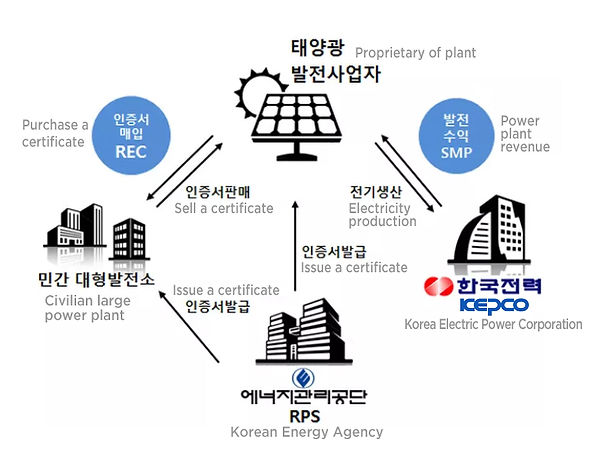태양광 발전사업의 수익구조?
Profit Model
-
한국전력공사에 태양광 전기를 판매하는 발전수익(SMP)
-
공급의무자로 지정해 놓은 민간 대형발전소에 판매하여 얻는 발전수익(REC)
-
Power Generation Revenue (SMP) to Sell Solar Power to KEPCO
-
Revenue generated from sales to large-scale civilian power plants designated as supply mandates (REC)

안정적인 수익률 10%이상 기대
문재인 정부의 RPS제도가 든든한 밑바탕
새로운 노후준비 투자 상품으로 각광
안정적 수익, 장기적 투자처
공급 과잉 無
'티끌 모아 태산'이라는 옛말이 무색하게 재테크 환경은 갈수록 어려워지고 있습니다. 저성장과 저금리 등의 시대가 도래하면서 재테크 투자처가 갈수록 줄어들고 있기 때문인데요. 부동산시장 역시 마찬가지입니다. 최근 몇 년 사이 노후 준비로 각광을 받던 오피스텔, 호텔등이 점점 그 인기를 잃어가고 있지만 그 대안으로 다른 부동산을 찾기란 쉽지 않습니다. 이같은 상황에서 태양광 발전 사업이 새로운 노후준비 투자상품으로 관심을 받고 있습니다.

Officetel Rental Yield
태양광 발전 사업은 태양의 빛을 이용해 전기를 생산하고 그렇게 해서 생산된 전기를 20년 장기고정 계약으로 한국전력공사와 발전자회사에 판매하는 사업입니다.
일단 공기업인 <한국전력>으로부터 수익이 나오기 때문에 안전성이 상당히 뛰어나다는 장점이 있습니다.
태양광 발전소 수익은 SMP(System Marginal Price)수익과 REC(Renewable Energy Certificate) 수익의 이원화 구조로서 투자대비 약 10%~12% 정도의 수익률을 기대할 수 있습니다.
※ 전력판매수익 = SMP + REC
※ 최근 20년 고정계약 체결 평균 단가 ( SMP + REC ) =184.5원
(2017년 하반기 기준)
SMP수익은 생산한 전기를 <한국전력>에 판매하여 얻는 수익이며, REC는 신재생에너지 공급인증서를 각 발전사에 판매함으로써 수익을 얻는 방식입니다.
REC의 경우 현재 평균가격이 KW당 60원 이상이며, 앞으로도 물가상승률을 뛰어넘는 상승률이 기대되기 때문에 수익성은 더 높아질 예상입니다.
또한 공기업인 <한국전력>이 SMP를 태양광 발전 사업이 중지되는 날까지 지급하기 때문에 안정적이며, REC 역시 500MW(메가와트)이상을 발전하는 18개 발전사(한국수력원자력, 한국남부발전 등)에 팔아 지속적인 수익률을 얻을 수 있습니다.

태양광 발전소는 수익형 부동산처럼 공급 과잉이 없어 사업이 실패할 확률이 적은데, 한전 선로 용량이 남아 있을 경우에만 허가가 나기 때문에 아무 곳이나 무작정 지을 수 없어 공급과잉이 일어 날 수 없는 구조이기 때문입니다.
다만 태양광 발전 사업을 개인이 직접 하려면 시간도 많이 걸리고 사업의 허가권과 같은 복잡한 요소가 많기 때문에 태양광 발전소 업체를 통해 사업을 진행하는것이 일반적입니다.
RPS : 신재생에너지 의무할당제 (Renewable energy Portfolio Standard)
REC : 신재생에너미 공급인증서 (Renewable Energy Certificates)
SMP : 계통 한계 가격 (System Marinal Price)
한국전력이 민간발전사업자로부터 전기를 사들이는 가격 (원/Kw)
문재인 정부의 RPS 제도가 태양광 발전 사업의 든든한 밑바탕이 되고 있습니다.
정부는 신,재생 에너지 공급 의무량을 2012년 2%로 시작해 2030년 이후에는 20%를 목표로 점점 그 비율이 늘어나도록 시행령에 명시되어 있습니다. 또한 소규모 사업자 보호를 위하여 의무량의 50% 이상을 외부로부터 구매하도록 하고 있습니다.

.
- Expect more than 10% of stable return on investment
- Based on the RPS system of the Moon Jae-in government
- New aging-prepared investment product spotlights
- Stable return, long term investment
- No oversupply
The technology environment is getting harder and harder. As the era of low growth and low interest rates comes, the number of investments in finance is decreasing. The same is true for the real estate market. Officetels and hotels, which have been in the limelight in recent years for their retirement, are losing their popularity, but it is not easy to find another property as an alternative. Under these circumstances, the Solar power generation business is attracting attention as a new retirement investment product.
The solar power generation business produces electricity using the light of the sun and sells the generated electricity to KEPCO and subsidiaries under a 20-year long term contract.
First of all, the profit comes from the public corporation, KEPCO.
Revenue from Solar Power Plant is a dual structure of SMP (System Marginal Price) revenue and Renewable Energy Certificate (REC) revenue.
※ Power sales revenue = SMP + REC
※ Average unit price (SMP + REC) = 184.5 won
(As of the second half of 2017)
SMP revenue is obtained by selling the generated electricity to KEPCO, and REC is a method of earning revenue by selling new renewable energy supply certificates to each power company.
For REC, the average price is over W60 / KW and profitability is expected to increase further as inflation is expected to exceed the inflation rate.
It is stable because the public corporation, KEPCO, pays SMP until the day when the photovoltaic power generation business ceases. You can sell to get a consistent return.
Solar power plants are less likely to fail because there is no oversupply, like a profitable real estate. .
However, it is very time consuming for a person to do a solar power business directly, and there are many complex factors such as permission of the project. That is why it is common to conduct business through solar power companies.
RPS: Renewable Energy Portfolio Standard
REC: Renewable Energy Certificates
SMP: System Marinal Price
KEPCO purchases electricity from private generators (KRW / Kw)
The Moon Jae-in government's RPS system is the foundation of the solar power business.
The government has stated in the Decree that the ratio of new and renewable energy supply will start at 2% in 2012 and increase to 20% after 2030. In addition, in order to protect small business owners, more than 50% of the amount required is purchased from outside.
